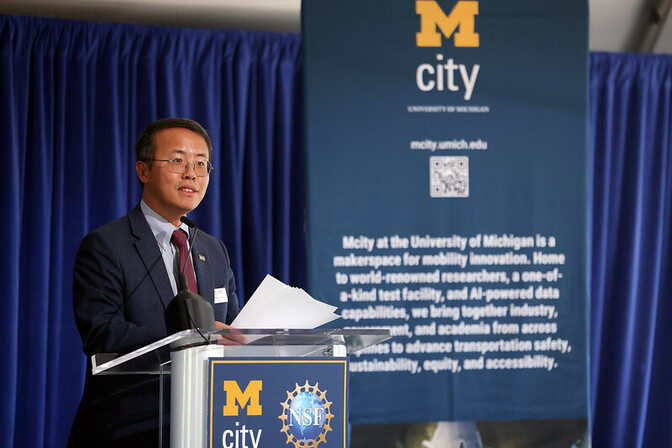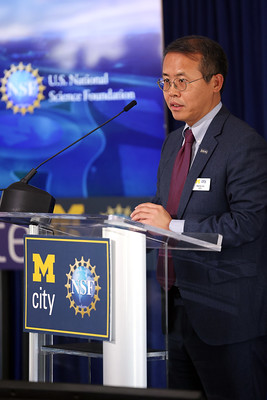
Henry Liu to lead expanded UMTRI that includes Mcity
New structure will serve as a force multiplier in efforts to reimagine the future of transportation.

New structure will serve as a force multiplier in efforts to reimagine the future of transportation.
Experts
The University of Michigan plans to bring two of its key mobility centers under one organizational roof in 2025 when the U-M Transportation Research Institute (UMTRI) expands through the integration of the Mcity public-private partnership and test facility.
Henry Liu, Mcity’s director since early 2022 and a professor of civil and environmental engineering, will lead the expanded UMTRI. Liu, a longtime UMTRI research professor, also serves as director of the U.S. Department of Transportation’s Center for Connected and Automated Transportation based at U-M and the Michigan Traffic Lab.
Liu will take on the new role as UMTRI’s director on March 1, 2025. As announced in September, James Sayer, UMTRI’s director for the past nine years, will step down from that role but remain as a research scientist. David W. Eby, an UMTRI associate director, head of the institute’s Behavioral Sciences Group, and 31 year faculty member at UMTRI will step into the role of deputy director.
“This new structure builds on UMTRI’s six decades of leadership by integrating Mcity’s world class research partnership and facilities. We believe it will serve as a force multiplier in the University of Michigan’s efforts to reimagine the future of transportation,” said Karen A. Thole, the Robert J. Vlasic Dean of Engineering and a professor of mechanical and aerospace engineering.
“We are deeply grateful to Jim for his exceptional leadership and vision over the years. His dedication will have a lasting impact,” Thole added. “Henry’s accomplishments at Mcity paired with his international reputation as a leader in the field of mobility make him an ideal next leader for an expanded UMTRI.”
Both UMTRI and Mcity have helped establish U-M as a global leader in transportation and mobility research, with work that has touched on everything from safety, to planning, to new autonomous and connected vehicle technologies.
It began with UMTRI 60 years ago, when Ford, General Motors and the Automobile Manufacturers Association helped found the institute in 1965 with a $10 million grant aimed at reducing traffic fatalities. Since then, UMTRI has led in crash and driving data analysis, driver behavior, injury biomechanics and ergonomics, occupant restraint systems and traffic modeling.
Over the years, UMTRI has produced thousands of research publications. Its early work transformed occupant and child restraint systems, air bags and traffic infrastructure. Much of its research has become the foundation of safety practices and policies around the globe.

In 2013, UMTRI leaders including Sayer envisioned, designed and launched Mcity, opening its test facility in 2015 as the world’s first purpose-built test track for connected and automated vehicles. Today, UMTRI operates a living lab through the Smart Intersections Project and the Ann Arbor Connected Environment 2.0 Project, which are outfitting nearly 75 intersections and other traffic infrastructure sites in Ann Arbor with cellular vehicle-to-everything (C-V2X) technology.
“UMTRI is one of the premier transportation and mobility research organizations in the world and Professor Liu will no doubt add to a rich history of research excellence and innovation,” Sayer said. “UMTRI experts have shaped modern transportation through vehicle systems, connectivity, automation and infrastructure, and they will continue to make significant contributions toward saving lives and reducing injuries associated with traffic crashes. I look forward to working with Henry over the coming months as he transitions into this new role.”
Mcity’s capabilities have grown in recent years as well, adding an AI data engine and mixed-reality, remote testing capabilities. That expansion, made possible by the National Science Foundation, created a digital infrastructure overlaying the physical test facility, allowing researchers without testing facilities at their institutions to remotely access Mcity’s technologies—bringing more people to the mobility table.
Beyond facilities and tools, Mcity offers student programs and funds research. Built on a foundation of strong interdisciplinary partnerships with industry, government and academia, Mcity’s commitment to public-private collaboration will continue as part of UMTRI.
“Combining Mcity and UMTRI will allow us to draw on the strengths of each to pursue a growth strategy grounded in collaboration,” said Liu, the Bruce D. Greenshields Collegiate Professor of Engineering. “Our work will build on the success that UMTRI and Mcity have achieved individually and further enhance U-M’s leadership in mobility research.”